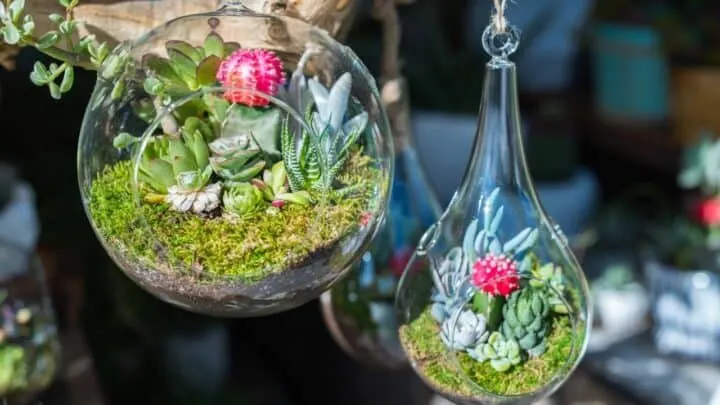High humidity is usually the reason for planting plants in a terrarium. It automatically raises the humidity levels.
But there are also scenarios where you might want to lower the humidity in a terrarium.
So, let’s find out how this can be achieved.
Table of Contents
How to decrease the humidity in a terrarium
To decrease the humidity in a terrarium, ventilation is essential. Closed terrariums should be aired periodically; open ones benefit from stopping misting. Reducing water in the enclosure also lowers humidity. In terrariums with large plants, their removal leads to an immediate humidity drop.
Ventilate closed terrariums
The surest and fastest way to drop the humidity in a closed terrarium is to remove the lid to air it out.
This ought to be done monthly. The smaller the terrarium, the less air it will need.
Generally, glass bottle terrariums need to be aired around 20 minutes to a half-hour each month. Larger terrarium tanks may need the lid removed monthly for a couple of hours.
Let open terrariums cool
In an open terrarium, the air circulation will already be there. The fastest way to drop humidity in an open terrarium is to reduce the air temperature.
The cooler the air is inside the terrarium, the less vapor it holds. The result is a lower humidity level.
Substrates and their effect on humidity
Different terrariums have different substrates. Some hold more water than others. Sometimes, that is what you are going for.
For example, regular potting soil is suitable for growing moss in a terrarium because moss has to have high humidity.
On the other hand, if you plant a terrarium with succulents, the base is lined with sand or gravel to hold moisture. The more water is held by the substrates, the higher the humidity levels become.
That is why succulents can only survive in open terrariums, while moss needs to be grown in a sealed enclosure.
There are times when the soil is moist, yet the humidity is not as high as you need it to be.
Changing humidity without adding water
Since it is not a good idea to water wet substrates (risking rot or fungi growth), putting a water dish into the terrarium is the alternative.
The more water is in the bowl, and the warmer the temperature is the faster humidity increases.
Naturally, when you raise the humidity that way, lowering it is done by taking the water bowl away.
The water bowl trick is how to keep a terrarium humid without wetting the soil. It only decreases humidity if you start using this method to maintain humidity rather than regularly misting.
The problem with misting is that directly misting inside the enclosure is permanent.
To remove excess moisture, the terrarium will need to be cooled and aired for the excess water to evaporate out of the enclosure. That takes time.
Removing a water bowl gives an almost instant drop in humidity.
All about temperatures, heat mats, and grow lights
Temperatures inside and around the terrarium impact the humidity within the enclosure.
The warmer the air temperature is, the more water molecules the air inside the terrarium holds.
Indirectly influencing the air temperature are what is above and around the terrarium and the plants within it.
Heat mats under the terrarium and grow lights over it will increase the temperature of the plants, the gravel base, and the air temperature.
If you use grow lights, move them farther away from the terrarium to drop the humidity by lowering the amount of heat being channeled into the enclosure.
When terrariums are placed in sunlight to meet their light requirements, move the terrarium to a shaded location or use a shade cloth to filter the sunlight until the humidity drops to the levels you need.
The room temperature also plays a part in humidity control. When the glass is warmer inside than on the outside, you will get condensation.
Condensation is normal a few times daily, but a terrarium should never be constantly fogging. When it does, it is a sign of too much water in the system.
Ventilating lets moisture escape, lowering the humidity levels.
Take plants out or cut them back
An overcrowded terrarium will have high humidity. The more water is released from the plant’s natural respiration process, the higher the humidity levels are.
The fastest way to correct that is to either take some away or prune them back.
Certain plants grow ferociously in terrariums and do need to be removed. The Ficus Benjamina tree is one that quickly outgrows terrariums.
Ferns such as the Golden Pothos and button ferns need to be pruned, or they will keep on growing. The bigger the plants get, the higher the humidity climbs.
Frequently Asked Questions related to decreasing the humidity in a terrarium.
Is it okay for the leaves to touch the glass?
Leaves need to be kept pruned. When they grow long enough to touch the glass, the foliage blocks the water from reaching the soil. Water should pour down the glass, through the substrate, then rise. When leaves get watered directly, the soil dries, roots get damaged and humidity levels fluctuate.
Will installing a fan lower humidity?
Installing a fan will drop humidity levels. They are not typically used in a standard terrarium. They look unsightly in glass containers and they can drop levels too low for some species of tropical plants. These are more suited to a vivarium where the animals are reliant on low to medium humidity.

Daniel has been a plant enthusiast for over 20 years. He owns hundreds of houseplants and prepares for the chili growing seasons yearly with great anticipation. His favorite plants are plant species in the Araceae family, such as Monstera, Philodendron, and Anthurium. He also loves gardening and is growing hot peppers, tomatoes, and many more vegetables.


